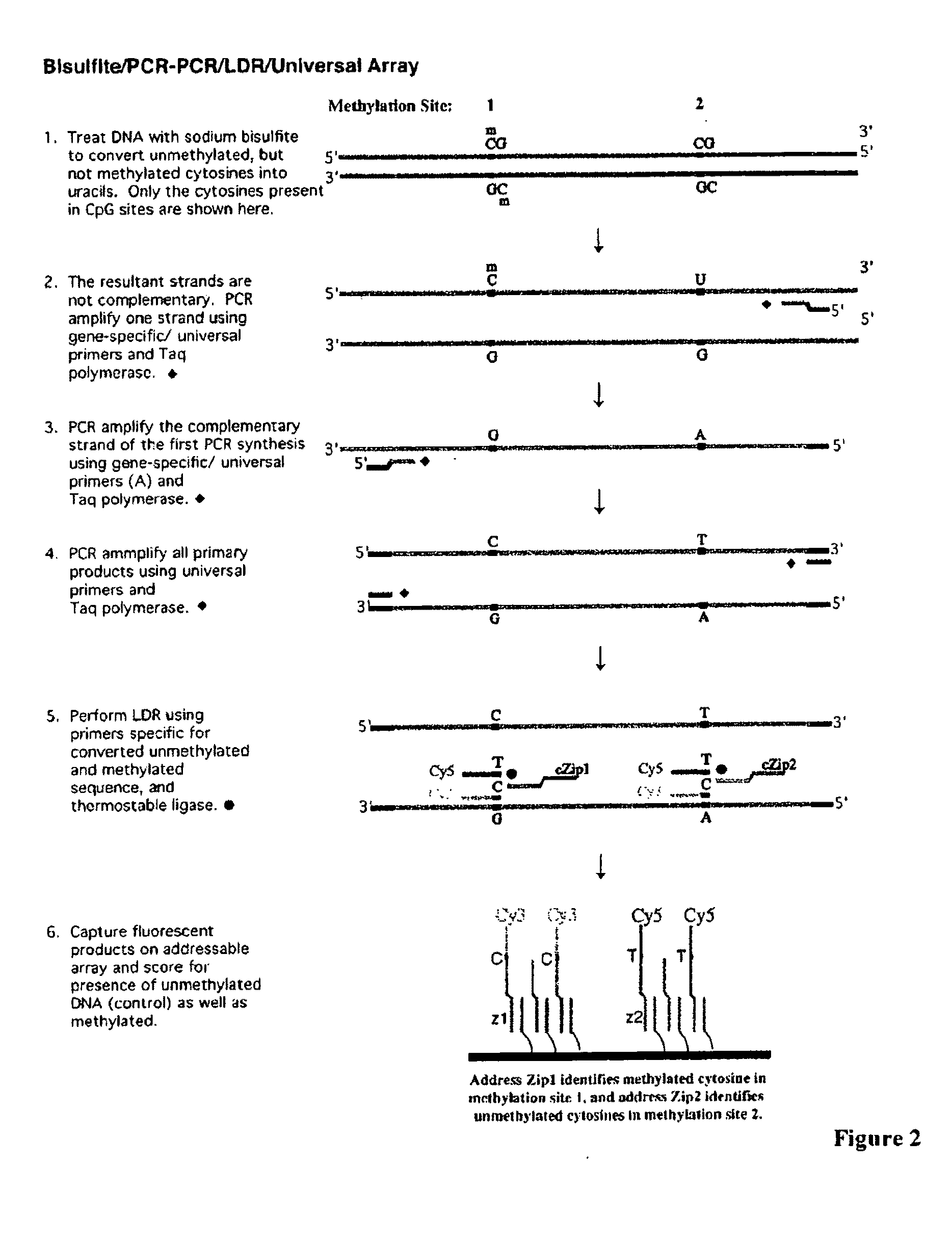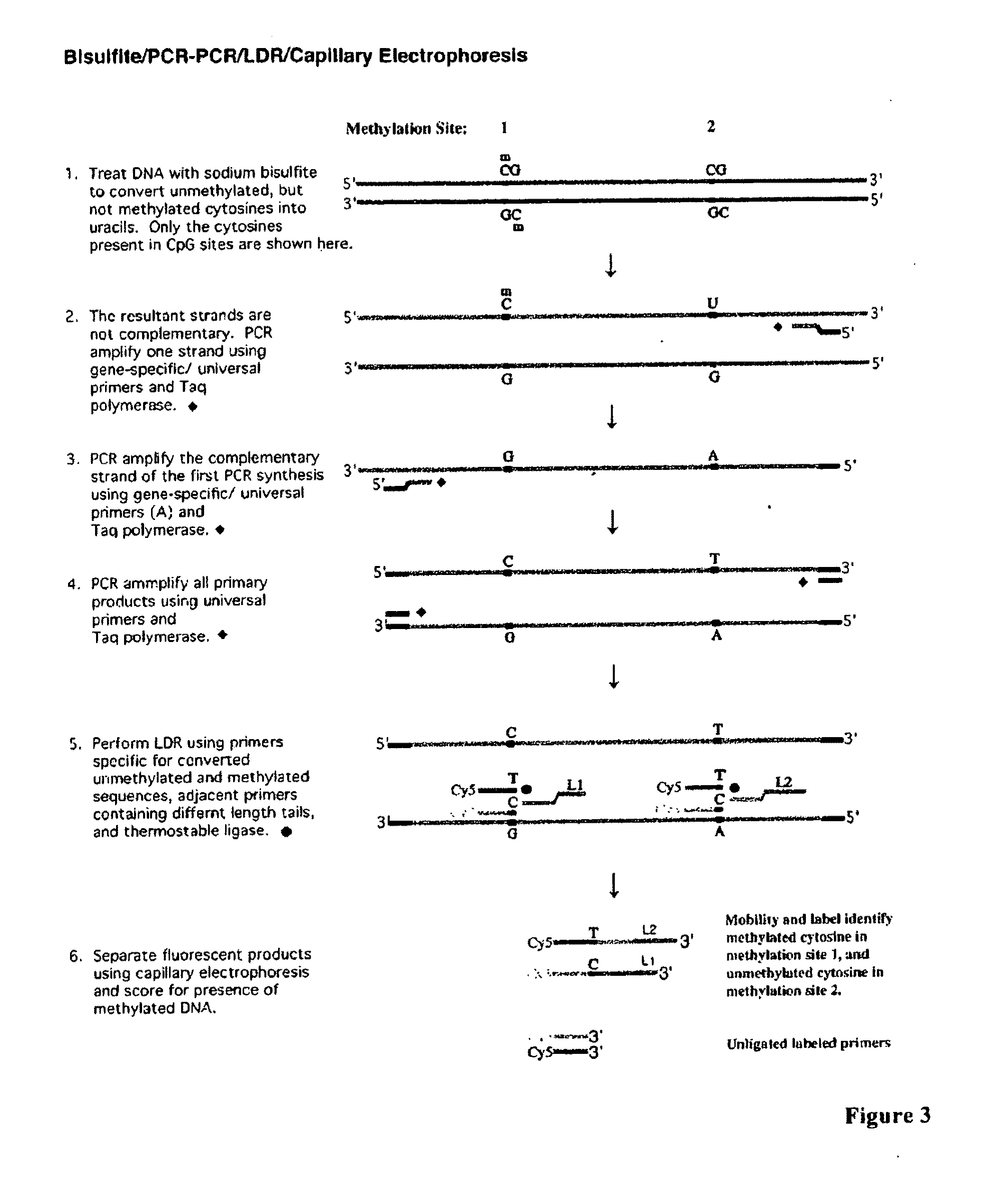Use of lecithin:retinol acyl transferase gene promoter methylation in evaluating the cancer state of subject
a technology of retinol acyl transferase and gene promoter, which is applied in the field of lecithin : retinol acyl transferase (lrat) gene promoter methylation in cancer diagnosis and prognosis, can solve problems such as critical gene expression errati
- Summary
- Abstract
- Description
- Claims
- Application Information
AI Technical Summary
Benefits of technology
Problems solved by technology
Method used
Image
Examples
example 1
Reagents and Media
[0109]All routine chemical reagents were purchased from Sigma Chemicals (St. Louis, Mo.) or Fisher Scientific (Fair Lawn, N.J.). Deoxyoligonucleotides were ordered from Integrated DNA Technologies Inc. (Coralville, Iowa). PCR buffer and AmpliTaq Gold were purchased from Applied Biosystems (Foster City, Calif.). Human genomic DNA was purchased from Roche (Indianapolis, Ind.). Colorectal, breast, and prostate cancer cell lines were obtained from American Type Culture Collection (ATCC) (Manassas, Va.) and cultured under the ATCC recommended media conditions. Fresh frozen primary colorectal adenocarcinomas were obtained from Memorial Sloan Kettering Cancer Center (New York, N.Y.) under IRB approved protocols. SssI methylase was purchased from New England BioLabs (Beverly, Mass.). Proteinase K was purchased from QIAGEN (Valencia, Calif.).
[0110]A 20 μl ligase detection reaction (LDR) contains 20 mM Tris pH 7.6, 10 mM MgCl2, 100 mM KCl, 10 mM DTT, 0.5 mM NAD, 25 mM Tth li...
example 2
Sodium Bisulfite Treatment of Genomic DNAs
[0111]Sodium bisulfite has been widely used to distinguish 5-methylcytosine from cytosine. Bisulfite converts cytosine into uracil via a deamination reaction while leaving 5-methylcytosine unchanged. Genomic DNAs extracted from tumor cell lines and colon tumor samples were used in this study. Typically, 1˜0.5 μg genomic DNA in a volume of 40 μl was incubated with 0.2N NaOH at 37° C. for 10 minutes. Next, 30 μl of freshly made 10 mM hydroquinone and 520 5,580,9671 of freshly made 3M sodium bisulfite were added to the reaction. Sodium bisulfite (3M) was made with 1.88 g sodium bisulfite (Sigma Chemicals, ACS grade) dissolved in a final total of 5 ml deionized H2O at pH 5.0. The bisulfite / DNA mixture was incubated for 16 hours in a DNA thermal cycler (Perkin Elmer Cetus) with the cycles of 50° C. for 20 minutes followed by a denaturation step at 85° C. for 15 seconds. The bisulfite treated DNAs were desalted using MICROCON centrifugal filter de...
example 3
Multiplex PCR Amplification
[0112]Two promoter regions of the LRAT gene were simultaneously amplified in a multiplex fashion. The multiplex PCR has two stages, namely a gene-specific amplification (stage one) and a universal amplification (stage two). The PCR primers are shown in Table 1.
[0113]The gene-specific PCR primers were designed such that the 3′ sequence contains a gene-specific region and the 5′ region contains an universal sequence. The gene specific primers were designed to hybridize to promoter regions containing as few CpG sites as possible. For primers that inevitably include one or more CpG dinucleotides, the nucleotide analogs, K and P, which can hybridize to either C or T nucleotides or G or A nucleotides, respectively, can be included in the primer design. To reduce the cost of primer synthesis, PCR primers were designed without nucleotide analogs and using nucleotides G to replace K (purine derivative) and T to replace P (pyrimidine derivative), respectively (Table...
PUM
| Property | Measurement | Unit |
|---|---|---|
| melting temperatures | aaaaa | aaaaa |
| temperature | aaaaa | aaaaa |
| temperature | aaaaa | aaaaa |
Abstract
Description
Claims
Application Information
 Login to View More
Login to View More - R&D
- Intellectual Property
- Life Sciences
- Materials
- Tech Scout
- Unparalleled Data Quality
- Higher Quality Content
- 60% Fewer Hallucinations
Browse by: Latest US Patents, China's latest patents, Technical Efficacy Thesaurus, Application Domain, Technology Topic, Popular Technical Reports.
© 2025 PatSnap. All rights reserved.Legal|Privacy policy|Modern Slavery Act Transparency Statement|Sitemap|About US| Contact US: help@patsnap.com



